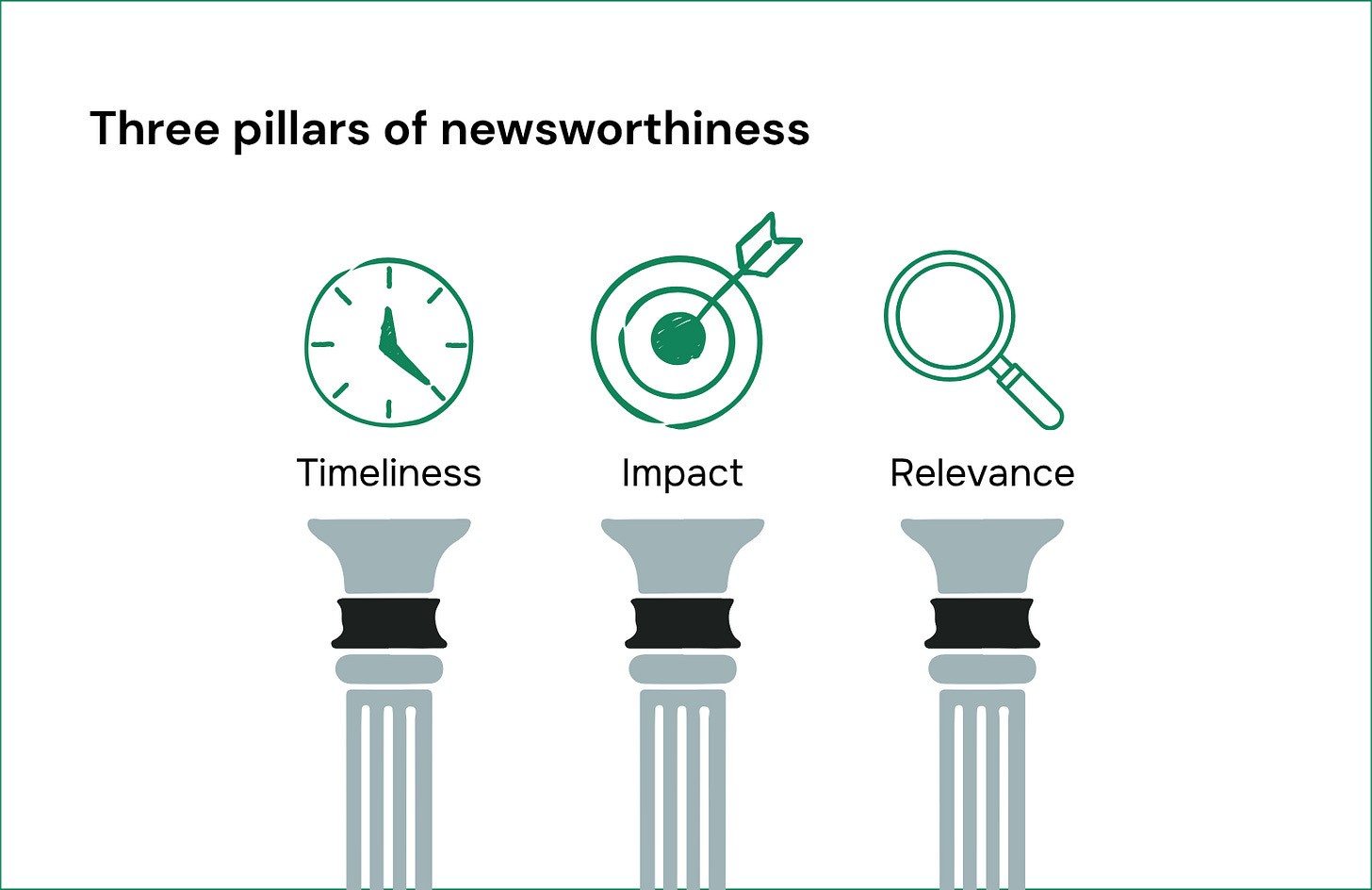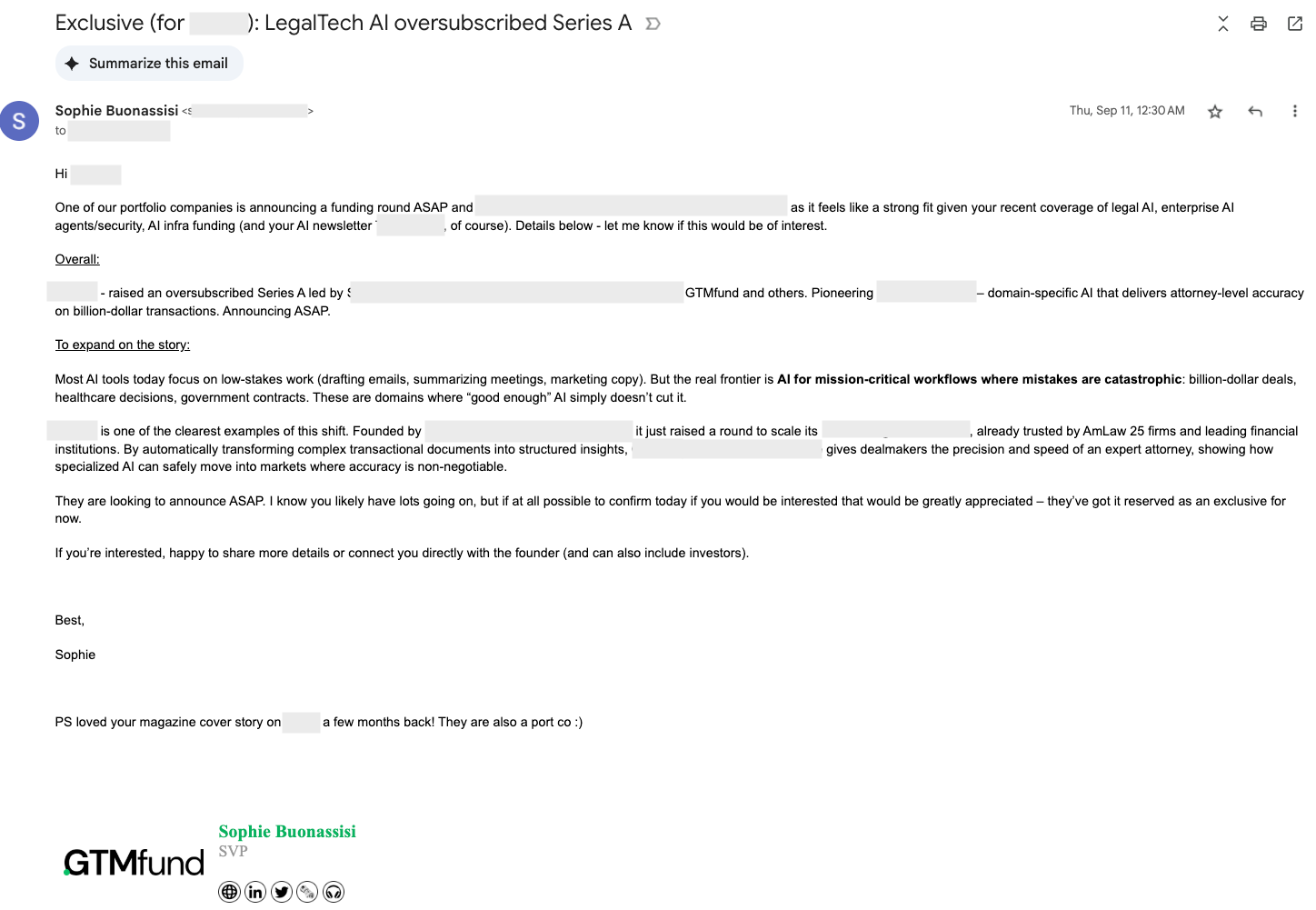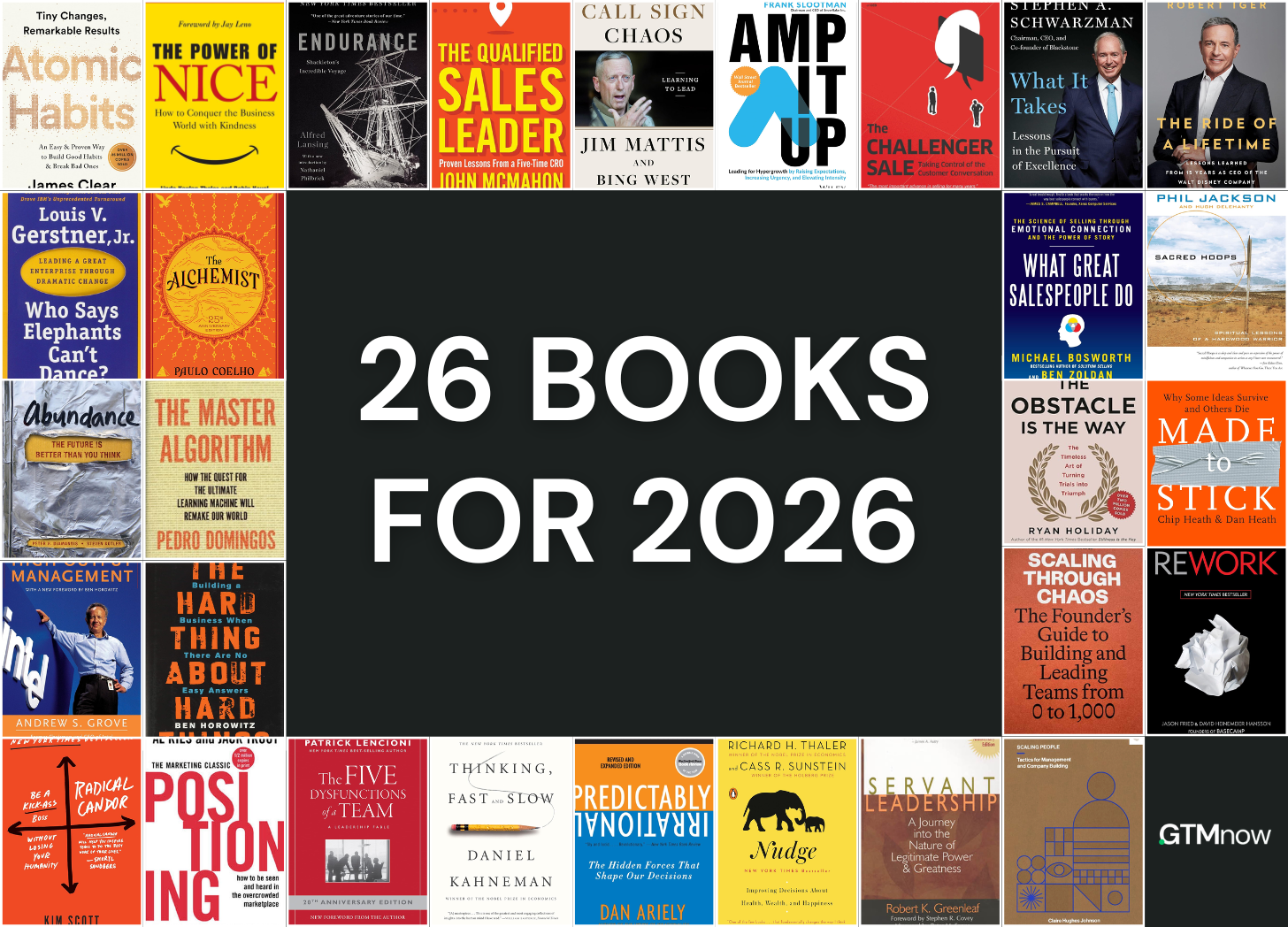The Ultimate PR Guide for Startups

Hello and welcome to The GTMnow Newsletter – the media brand of VC firm, GTMfund. Build, scale and invest with the best minds in tech.
“I want to be in TechCrunch, Forbes, etc.”
It’s one of the most common lines we hear as investors.
But PR still feels like a black box for most founders, especially those running a process for the first time. We often compare it to a wedding: you plan it once (maybe multiple) so the planning process feels new. Even if it’s not the first, the people, venue, and timing change every time.
Repetition builds understanding, but early-stage companies rarely get that repetition with PR.
In this edition, we break down step by step how to land in your dream outlet.
Over the past year, we’ve support our portfolio companies in securing placements that amplified their stories. We’ve also been fortunate to earn coverage for GTMfund’s fund announcements.
And just this week, Max (GTMfund’s GP) joined the Head of Startups at OpenAI and the CMO of Google Cloud on stage at TechCrunch Disrupt to discuss building a modern GTM engine.
The standing-room-only crowd of founders and investors was proof in itself: GTM has become one of the most critical success factors for today’s companies.



The Friction Report reveals what’s slowing down global software sales, and how to fix it. In this new industry report, Cleverbridge analyzed hundreds of SaaS companies to uncover the key friction points hurting revenue growth. From checkout drop-offs and localization challenges to subscription churn, it’s packed with data-backed insights on how leading software companies are optimizing every step of the digital commerce journey.
Check the full report here.
PR Glossary
Before we get into the process, this is a helpful glossary of PR terms to know:

Your PR Guide
We’ve helped dozens of startups secure coverage for their funding announcements.
This is a step-by-step breakdown of how to run an effective process when announcing a round.
Step 1: Set your goals
Before launching any PR campaign, start by clarifying why you’re doing it. Are you trying to support recruiting? Build legitimacy with investors? Open doors for enterprise partnerships?
Your objective determines your story, your messaging, and the outlets you prioritize.
Sales often comes up as a goal, and while it can be PR should be viewed as a credibility engine, not a pipeline generator. It’s the fuel that validates your narrative, not the vehicle that carries it.
Think of PR as jet fuel: when layered on top of your owned channels, it amplifies momentum and reinforces trust.
For example:
- Anything drove massive visibility through virality on X (over 3M views on this post), hitting $2M ARR in just two weeks. When they later announced $11M in funding at a $100M valuation, TechCrunch coverage added credibility to the momentum they’d already created.
- Paid announced a $21M Seed round, landing TechCrunch coverage that reinforced their traction. The announcement post from Founder & CEO Manny Medina generated over 1,000 reactions on LinkedIn, signalling validation to both investors and customers.
A great press hit is third-party validation. It tells investors, recruits, and partners: this company is worth paying attention to.
Step 2: Identify ideal outlets based on those goals
Your goals should guide which outlets to prioritize.
If your objective is fundraising or hiring, focus on Tier I outlets with broad tech reach, like TechCrunch or Forbes. These help validate your brand and can signal credibility to investors and talent.
If your goal is demand generation, prioritize industry-specific publications that your ICP reads. Relevance will drive far more qualified awareness than reach alone.
Step 3: Ask your investors if they have connections to those outlets
Unless you already have reporter relationships from a previous venture or you’ve been intentional about building them early, you may not have direct access to the outlets.
This is where your investors can help. They may have existing relationships with reporters and can offer warm introductions or guidance on which outlets are most responsive. Don’t hesitate to ask.
Here’s a simple message you can send as a starting point:
“Hi {{first name}} – really excited to share that we’ll be announcing our $XX [round] raise soon. We’re kicking off the PR process and are targeting {{outlet}} and {{outlet}}. Wanted to reach out and see if you happen to have any contacts at those outlets, before we dive into things from our end.”
Step 4: Identify the specific reporters at your target outlets
Now, the ideal scenario would be that you’ve started to build reporter relationships early. Most founders only think about reporters when they have news to share. But PR, much like sales, rewards relationship-building over time. Cold pitching rarely works as well as warm outreach built on familiarity and trust.
Start early if you can. Identify 5–10 reporters who consistently cover your category, and begin following and engaging with their work.
Lead with value before you ever make an ask. That could mean sharing relevant industry data, connecting them with credible sources, or simply commenting thoughtfully on their pieces. Over time, that consistency builds recognition.
Then, when you do have news, the relationship already exists and offering exclusivity to a trusted journalist can significantly improve your chances of meaningful coverage.
This rarely happens in practice — founders are juggling every part of company building.
That’s why it’s valuable to ask your investors about connections. They may have provided a few names or none at all. Either way, the next step is to evaluate which reporters are actually relevant to your story.
Reporters typically cover specific beats, which are defined focus areas like AI, fintech, or enterprise software. You’ll want to make sure your announcement aligns with what they write about.
Start by finding reporters who cover your specific category. Search their profiles on the outlet’s website, read their recent articles, and note the themes they tend to highlight.
This will help you build a short, focused list of journalists who are most likely to be interested in your announcement (and prevent you from wasting effort on broad or misaligned outreach).
Step 5: Craft your story
You need to understand what makes a story newsworthy.
What might feel exciting internally isn’t necessarily compelling to reporters. Jenny He (GP at Position Ventures) lays out a framework below to evaluate whether a story is actually newsworthy.
The three pillars of newsworthiness:
- Timeliness – Ask: Would this story still matter if published 2 weeks later? If not, it’s timely.
- Impact – Map out how many people are affected (impact) and who cares (relevance).
- Relevance – Layer in third-party quotes, investor testimonials, and customer anecdotes to strengthen the pitch.

A strong story hits all three:
- A meaningful announcement (the what)
- A unique founder or company backstory (the who)
- And clear relevance to a broader trend (the why now)
When those elements align, you’ve got the kind of story reporters want.
Journalists are asking themselves three questions: Why this story? Why now? Why will my audience care?
That’s why your positioning matters so much.
Most teams rush into PR hoping for a splashy launch moment. But without a differentiated position, even a big announcement can fall flat. Before writing a press release or talking to a reporter, you need to be able to clearly and defensibly articulate your “why us.”
Think of positioning as your North Star. It’s not just about your product, it’s about how you’re uniquely solving a real, painful problem for a specific customer. That clarity becomes the foundation for your narrative, your storytelling, and ultimately, your PR angle.
“A reporter gets hundreds of emails per day and has seen 100 companies in the same space. You need to be so differentiated that they want to write about you.” – Jenny
Step 6: The outreach
You have three options for conducting outreach:
- You can do so in-house yourself
- You can hire a PR consultant
- You can hire a PR agency
All come with their benefits, drawbacks, and cost differences.
For Seed and Series A stage companies, hiring a PR consultant is often going to be the most effective while being cost (capital and time) efficient.
When it comes to outreach, one key detail matters: exclusivity. Reporters are more likely to engage when they have the chance to break a story first. But exclusives come with nuance. You should only offer exclusivity to one reporter at a time. Think of it as a waterfall process:
- Reach out to your top-choice reporter first.
- Offer the exclusive with a clear, short window (“This exclusive is open until [date/time]”).
- If you don’t hear back within that window, move to the next reporter on your list.
This keeps your process clean, professional, and efficient while respecting journalists’ time and maintaining control over your announcement timeline.
Here’s an outreach email example that we sent for a portfolio company, which got a positive response and exclusive feature:

Tag @GTMnow so we can see your takeaways and help amplify them.
More for your eyeballs
Superhuman is being acquired by Grammarly to build the AI-native productivity suite of choice. Together, the teams plan to deepen investments in AI and email, reimagine chat and collaboration, and develop AI agents that unlock a new way of working.
Figma acquired Weavy and introduced it as Figma Weave, bringing AI and creative editing tools together on a single canvas. The move lets users mold AI outputs as a new medium, blending human craft with AI generation to unlock more creative expression.
On How I Hire, Andy Mowat talks with Guy Yalif, Chief Evangelist at Webflow, about why product marketing is the hardest role to hire for. Guy shares frameworks like altitude assessment, blind references, and simulated meeting interviews that help leaders separate good from great talent.
More for your eardrums
Get a sneak preview here. For the full thing, listen on Apple, Spotify, YouTube or wherever you get your podcasts by searching “The GTMnow Podcast.”
Startups to watch
Oureon – raised a $3.5M pre-seed led by GTMfund and came out of stealth to build a real-time communication layer for the sky. The platform connects manned and unmanned aircraft so they can communicate, predict, and deconflict in real time as 800M new drone flights enter global airspace.
Casium – raised $5M to help employers hire and onboard global talent faster. The platform streamlines international hiring, compliance, and payroll, giving companies a simpler way to expand teams across borders.
Hottest GTM jobs of the week
- Account Executive, New Business at Spekit (Remote – US)
- Customer Success Manager, Strategic at Owner.com (Remote – US/Canada)
- VP Marketing at Gorgias (Hybrid – NYC)
- Senior Demand Generation Marketing Manager at Noibu (Hybrid – Toronto)
- Global Demand Generation Manager at Vanta (Remote – US)
- See more top GTM jobs on the GTMfund Job Board.
GTM industry events
Upcoming events you won’t want to miss:
- Momentum Virtual Event: Ignite your GTM with AI: November 5, 2025
- Momentum Book Tour: Leadership Dinner: November 5, 2025 (New York, NY)
- Midnight to Millions: November 6 at 12PM EST (Online)
- GTMfund Dinner (private registration): November 18, 2025 (Toronto, ON)
- GTMfund Dinner (private registration): November 19, 2025 (New York, NY)
- Founder Breakfast by GTMfund & 645 Ventures (private registration): November 21, 2025 (New York, NY)
- Above the Fold (for marketers): February 9-11, 2025 (Fort Lauderdale, FL)
- Spryng (for marketers): March 24-26, 2025 (Austin, TX)
GTMnow community love
Some GTMnow community (founder, operator, investor) love to close it out – we appreciate you.






